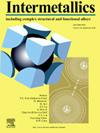重温轧制对极低层错能高熵合金组织和性能的影响
IF 4.8
2区 材料科学
Q2 CHEMISTRY, PHYSICAL
引用次数: 0
摘要
本研究重点研究了重温轧制(厚度减少90%)对极低层错能(SFE) Co20Cr26Fe20Mn20Ni14高熵合金(HEA)显微组织、织构和力学性能的影响。通过将结果与重冷(CR)/冷轧(CryoR)低SFE合金进行比较,进一步证实了这一发现。在650°C下进行WR,厚度减少90%,形成了多种微观组织特征,如位错胞(亚结构)、变形孪晶、剪切带、富cr的σ相析出,以及变形驱动的带状纳米结构,层间间距为130±30 nm。此外,WR导致主要的黄铜型织构的发展。退火到950℃时,由于σ相的存在抑制了晶粒的生长,形成了完全再结晶的细小组织;然而,在此之后,析出相被溶解并刺激了显著的晶粒生长。退火织构显示出弱α-纤维(ND//<110>)组分的保留和随机组分的高体积分数,可能是由于缺乏主导的优先形核或优先生长机制。由于细小的再结晶晶粒尺寸和大量的晶内析出物,在wr加工的HEA中实现了明显的强度-塑性平衡(~ 1 gpa - 20%),这与其他几种HEAs相比是有利的。因此,WR可能是一种有吸引力的加工策略,用于工程化低SFE HEAs的微观结构和性能。本文章由计算机程序翻译,如有差异,请以英文原文为准。
Impact of heavy warm-rolling on microstructure and properties of an extremely low stacking fault energy high entropy alloy
This research focused on the influence of heavy (∼90 % reduction in thickness) warm-rolling (WR) on the microstructure, texture, and mechanical properties of an extremely low stacking fault energy (SFE) Co20Cr26Fe20Mn20Ni14 high entropy alloy (HEA). The findings were further contextualized by comparing the results with heavy cold- (CR)/cryo-rolled (CryoR) low SFE alloys suitably. The WR was carried out at 650 °C up to 90 % thickness reduction, resulting in the formation of various microstructural features like dislocation cells (sub-structures), deformation twins, shear bands, precipitation of Cr-rich σ-phase, and a deformation-driven banded nanostructure with a remarkably fine inter-lamellar spacing of 130 ± 30 nm. Additionally, WR led to the development of a predominant brass-type texture. Annealing resulted in fully recrystallized fine microstructures up to 950 °C due to the presence of σ precipitates inhibiting grain growth; however, beyond which, the precipitates were dissolved and stimulated significant grain growth. The annealing textures showed the retention of weak α-fiber (ND//<110>) components and a high-volume fraction of random components, presumably due to the absence of dominating preferential nucleation or preferential growth mechanisms. An appreciable balance in strength-ductility (∼1 GPa-20 %) was achieved in the WR-processed HEA due to fine recrystallized grain size and large fraction of in-grain precipitates, which compared favorably with several other HEAs. Therefore, WR could be an attractive processing strategy for engineering the microstructure and properties of the low SFE HEAs.
求助全文
通过发布文献求助,成功后即可免费获取论文全文。
去求助
来源期刊

Intermetallics
工程技术-材料科学:综合
CiteScore
7.80
自引率
9.10%
发文量
291
审稿时长
37 days
期刊介绍:
This journal is a platform for publishing innovative research and overviews for advancing our understanding of the structure, property, and functionality of complex metallic alloys, including intermetallics, metallic glasses, and high entropy alloys.
The journal reports the science and engineering of metallic materials in the following aspects:
Theories and experiments which address the relationship between property and structure in all length scales.
Physical modeling and numerical simulations which provide a comprehensive understanding of experimental observations.
Stimulated methodologies to characterize the structure and chemistry of materials that correlate the properties.
Technological applications resulting from the understanding of property-structure relationship in materials.
Novel and cutting-edge results warranting rapid communication.
The journal also publishes special issues on selected topics and overviews by invitation only.
 求助内容:
求助内容: 应助结果提醒方式:
应助结果提醒方式:


